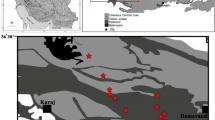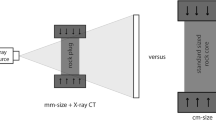Abstract
The Core Strangle Test (CST) has been proposed in 2009 by author as an index test permitting indirect estimation of the Uniaxial Compressive Strength. In this test, load is applied through a circle perpendicular to the core axis as a strangle. The mentioned advantage of the experiment is the possibility of testing quite short rock cores on which the UCS experiment cannot be performed. In the original paper published at 2009, the author performed several experiments on non-porous rocks on which the UCS has also been measured. The results showed a linear correlation between the UCS and the CST index permitting an indirect evaluation of the UCS by performing CST experiments. The current paper is quite similar to the original paper with the difference that the experiments are performed here on porous rocks of various porosity. CST and UCS of the rocks are shown to have both exponential correlations with the rock porosity. Once again a linear relation, quite close to the one in the original paper, is obtained for the UCS of the porous rocks as a function of the CST index. This study confirms that the CST experiment can also be used for porous rocks. Studying the feasibility of CST method on porous rocks seems to be a logical next step in the development of this experiment and the results clearly support it.





Similar content being viewed by others
References
Al-Harthi AA, Al-Amri RM, Shehata WM (1999) The porosity and engineering properties of vesicular basalt in Saudi Arabia. Eng Geol 54:313–320
Alvarez GM, Babuska R (1999) Fuzzy model for the prediction of unconfined compressive strength of rock samples. Int J Rock Mech Min Sci 36:339–349
Attewell PB, Farmer IW (1976) Principles of engineering geology. Chapman and Hall, London
Avar BB, Hudyma N, Karakouzian M (2003) Porosity dependence of the elastic modulus of lithophysae-rich tuff: numerical and experimental investigations. Int J Rock Mech Min Sci 40:919–928
Dearman WR, Baynes EJ, Irfan TY (1978) Engineering grading of weathered granite. Eng Geol 12:345–374
Dunn DE, LaFountain LJ, Jackson RE (1973) Porosity dependence and mechanism of brittle fracture in sandstones. J Geophys Res 78:2403–2417
Fakhimi A, Gharahbagh EA (2009) Discrete element modeling of the influence of void size and distribution on the mechanical behavior of rock. In: Diederichs M, Grasselli G (eds) ROCKENG09: Proceedings of the 3rd CANUS rock mechanics symposium, Toronto, May 2009, pp 1–11
Finol J, Guo YK, Jing XD (2001) A rule based fuzzy model for the prediction of petrophysical rock parameters. J Pet Sci Eng 29:97–113
Hatzor YH, Palchik V (1998) A microstructure-based failure criterion for Aminadav dolomites. Int J Rock Mech Min Sci 35(6):797–805
Hoshino K (1974) Effect of porosity on the strength of the clastic sedimentary rocks. In: Proceedings of 3rd Congress of the International Society for Rock Mechanics, Madrid, pp 511–516
ISRM (2007) In: Ulusay R, Hudson JA (eds) The complete ISRM suggested methods for rock characterization, testing and monitoring. Ankara, Turkey, Kazan Ofset Press
Kahraman S, Günaydın O, Fener M (2005) The effect of porosity on the relation between uniaxial compressive strength and point load index. Int J Rock Mech Min Sci 42:584–589
Knudsen FP (1959) Dependence of mechanical strength of brittle polycrystalline specimens on porosity and grain size. J Am Ceram Soc 42(8):376–387
Mohd BK (2009) Compressive strength of vuggy oolitic limestones as a function of their porosity and sound propagation. Jordan J Earth Environ Sci 2(1):18–25
Palchik V (2006) Application of Mohr-Coulomb failure theory to very porous sandy shales. Int J Rock Mech Min Sci 43:1153–1162
Palchik V, Hatzor YH (2002) Crack damage stress as a composite function of porosity and elastic matrix stiffness in dolomites and limestones. Eng Geol 63(3–4):233–245
Palchik V, Hatzor YH (2004a) The influence of porosity on tensile and compressive strength of porous chalks. Rock Mech Rock Eng 37(4):331–341
Palchik V, Hatzor YH (2004b) The influence of porosity on tensile and compressive strength of porous chalks. Rock Mech Rock Eng 37(4):331–341
Potyondy DO (2007) The effect of voids on the mechanical properties of rock. In: DEM 07, CD Proceedings of the Discrete Element Modeling Conference, August 27–29, 2007, Brisbane, Australia
Schöpfer MPJ, Steffen A, Conrad C, Walsh JJ (2009) The impact of porosity and crack density on the elasticity, strength and friction of cohesive granular materials: insights from DEM modeling. Int J Rock Mech Min Sci 46:250–261
Smoradinov MI, Motoviloss EA, Vokov VA (1970) Determination of correlation relationships between strength and some physical characteristics of rocks. In: Proceedings of 2nd Congress of the International Society for Rock Mechanics, Belgrade, pp 25–37
Vernik L, Bruno M, Bovberg C (1993) Empirical relations between compressive strength and porosity of siliciclastic rocks. Int J Rock Mech Min Sci Geomech Abstr 30(7):677–680
Yilmaz I (2009) A new testing method for indirect determination of the unconfined compressive strength of rocks. Int J Rock Mech Min Sci 46(8):1349–1357
Yilmaz I (2010) Use of the core strangle test for tensile strength estimation and rock mass classification. Int J Rock Mech Min Sci 47(5):845–850
Yilmaz I, Yucel Ö (2014) Use of the core strangle test for determining strength anisotropy of rocks. Int J Rock Mech Min Sci 66:57–63
Author information
Authors and Affiliations
Corresponding author
Rights and permissions
About this article
Cite this article
Yilmaz, I. Performance of Core Strangle Test (CST) on Porous Rocks. Geotech Geol Eng 36, 3551–3557 (2018). https://doi.org/10.1007/s10706-018-0556-1
Received:
Accepted:
Published:
Issue Date:
DOI: https://doi.org/10.1007/s10706-018-0556-1




